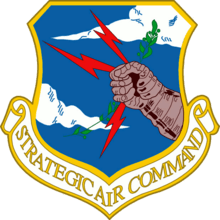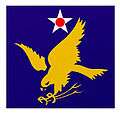351st Missile Wing
The 351st Missile Wing is an inactive United States Air Force unit, which was last based at Whiteman Air Force Base, Missouri. Assigned to Strategic Air Command for most of its existence, the wing supported LGM-30F Minuteman II ICBMs. It was inactivated in 1995.
| 351st Missile Wing | |
|---|---|
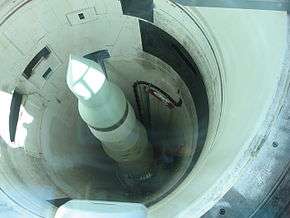 Minuteman Missile in its silo | |
| Active | 1942–1945; 1947–1949; 1962–1995 |
| Country | |
| Branch | |
| Type | Missile Wing |
| Role | Strategic Attack |
| Part of | Air Force Space Command |
| Garrison/HQ | Whiteman Air Force Base |
| Motto(s) | Sentinels of Peace |
| Decorations | Distinguished Unit Citation Air Force Outstanding Unit Award |
| Insignia | |
| 351st Missile Wing emblem (Approved 7 February 1964)[1] | |
| Unofficial 351st Bombardment Group emblem |  |
During World War II, its predecessor unit, the 351st Bombardment Group was a VIII Bomber Command B-17 Flying Fortress unit in England. Assigned to RAF Polebrook in early 1943, the group's 504th Bomb Squadron made 54 consecutive missions on June 1943 to January 1944 without losses. Two members of the 351st Bombardment Group, 2d Lt Walter E. Truemper and S/Sgt Archibald Mathies, were posthumously awarded the Medal of Honor on a mission to Leipzig, Germany, 20 February 1944.
The 351st was also the unit to which Captain Clark Gable was assigned.[note 1] Gable flew five combat missions, including one to Germany, as an observer-gunner in B-17 Flying Fortresses between 4 May and 23 September 1943, earning the Air Medal and the Distinguished Flying Cross for his efforts.
History
World War II
![]()
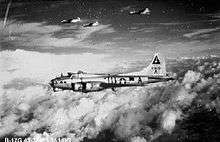
The 351st Bombardment Group was activated 1 October 1942 at Salt Lake City AB, Utah. The group established at Geiger Field in Washington in November 1942 where the Group was assembled for initial training, and the Second phase of training was conducted at Biggs Field, Texas, between December 1942 and March 1943. The unit then moved to Pueblo AAB, Colorado for preparation for overseas movement. The ground unit left Pueblo for New York on 12 April 1943. The aircraft began movement on 1 April 1943. In April–May 1943, the unit moved to RAF Polebrook England to serve in combat with Eighth Air Force. It was assigned to the 94th Combat Wing, also at Polebrook. The group tail code was a "Triangle J".

The 351st's first completed combat mission took place on 14 May 1943, when 18 B-17's targeted a German Luftwaffe airfield at Kortrijk, Belgium. As the war progressed, the 351st operated primarily against strategic objectives in Germany, striking such targets as ball-bearing plants at Schweinfurt, communications at Mayen, marshalling yards at Koblenz, a locomotive and tank factory at Hanover, industries at Berlin, bridges at Cologne, an armaments factory at Mannheim, and oil refineries at Hamburg.
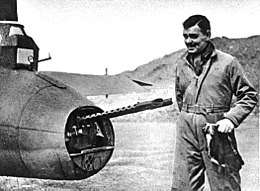
The group also struck harbor facilities, submarine installations, airfields, V-weapon sites, and power plants in France, Belgium, the Netherlands, and Norway.
The 351st Received a Distinguished Unit Citation (DUC) for performance on 9 October 1943, when an aircraft factory in Germany was accurately bombed in spite of heavy flak and pressing enemy interceptors. It received another DUC for its part in the successful attack of 11 January 1944, on aircraft factories in central Germany. The group participated in the intensive air campaign against the German aircraft industry during "Big Week", 20–25 February 1944.
In addition to its strategic missions, the group often operated in support of ground forces and attacked interdictory targets. Bombed in support of the Battle of Normandy in June 1944 and the Saint-Lô breakthrough in July. The group hit enemy positions to cover the airborne attack on the Netherlands in September 1944 and subsequently struck front-line positions, communications, and airfields to help stop the German counteroffensive in the Battle of the Bulge, December 1944 – January 1945. The 351st later flew missions in support of Operation Varsity, the airborne assault across the Rhine in March 1945.
The 351st conducted routine 8th Air Force missions from RAF Polebrook until the end of the war. The unit completed 311 combat missions from Polebrook. The 351st lost 175 B-17's and their crews. The gunners in the Group fired off 2,776,028 rounds of ammunition and were credited with destroying 303 enemy aircraft.
The Group was redeployed to the US in May and June 1945. The first aircraft left on 21 May 1945. The ground unit sailed for the US on 25 June 1945, aboard the Queen Elizabeth. The ship docked in the US in July 1945, but the group was not inactivated until 28 August 1945.
Cold War
![]()
During the early years of the Cold War, the 351st Bombardment Group (Very Heavy) was reactivated for a short period between 1947 and 1949 as part of the reserves.
Later during the Cold War, the United States Air Force and Strategic Air Command established the 351st Strategic Missile Wing, which stood alert with Minuteman I and later, Minuteman II ICBMs starting in 1963 at Whiteman AFB, Missouri. The wing was bestowed the lineage, honors and history of the USAAF 351st Bomb Group of World War II upon activation.
The 351st supervised missile training operations and coordinated construction of SM-30B (later, LGM-30B) Minuteman I missile facilities from 1 February 1963, to 29 June 1964. The first missile arrived 14 January 1964 and was placed its silo two days later. The 508th SMS became combat ready on 5 June and the 509th on 10 June 1964. The last flight of the fifteen missiles was accepted 29 June 1964, making the 510th operational. The wing then had 150 fully operational missiles. Two-officer missile combat crews were deployed to each of the LCCs for 24-hour shifts. Meanwhile, the 340th Bombardment Wing phased down for inactivation and 351st Strategic Missile Wing gradually assumed host-wing responsibilities at Whiteman AFB, between 1 July and 1 September 1963. Later, the Wing converted to LGM-30F Minuteman II missiles between 7 May 1966, and 3 October 1967.
The wing won the Colonel Lee R. Williams Memorial Missile Trophy for Calendar Years 1965, 1967 and 1973, as well as the SAC missile combat competition and Blanchard Trophy in 1967, 1971, 1977, 1981,1989, and 1993. It was named SAC's "Best Minuteman Wing" in 1972.
On 1 September 1991, the wing was redesignated as the 351st Missile Wing and implemented the objective wing organization. It was relieved from SAC in advance od SAC's disestablishment and reassigned to Eighth Air Force in the new Air Combat Command on 1 June 1992. It was again reassigned on 1 July 1993 to the Air Force Space Command and assigned to the new Twentieth Air Force. The same day, it relinquished "host wing" responsibilities for Whiteman AFB, transferring that role to Air Combat Command's 509th Bomb Wing, operating the B-2 Spirit strategic bomber.
The 351st Missile Wing and its three squadrons of Minuteman II ICBMs were inactivated on 31 July 1995 as a result of planned phaseout of the Minuteman II.
Lineage
- 351st Bombardment Group
- Constituted as the 351st Bombardment Group (Heavy) on 25 September 1942
- Activated on 1 October 1942
- Redesignated 351st Bombardment Group, Heavy on 11 August 1944
- Inactivated on 28 August 1945
- Redesignated 351st Bombardment Group, Very Heavy
- Activated on 9 April 1947
- Inactivated on 27 June 1949[2]
- Consolidated with the 351st Strategic Missile Wing as the 351st Strategic Missile Wing on 31 January 1984[3]
- 351st Missile Wing
- Established as 351st Strategic Missile Wing (ICBM—Minuteman) and activated, on 9 August 1962
- Organized on 1 February 1963[1]
- Consolidated with the 351st Bombardment Group on 31 January 1984[3]
- Redesignated as 351st Missile Wing on 1 September 1991
- Inactivated on 31 July 1995
Assignments
- II Bomber Command, 1 October 1942 – 12 April 1943
- 1st Bombardment Wing, May 1943 (attached to 101st Provisional Combat Bombardment Wing until 13 September 1943)
- 94th Combat Bombardment Wing, 1 November 1943 – 23 June 1945
- Army Service Forces (for inactivation), – 28 July August 1945
- Tenth Air Force, 9 April 1947 – 27 June 1949
- Strategic Air Command, 9 August 1962 (not organized)
- 17th Strategic Aerospace Division (later 17th Strategic MissileDivision, 17th Strategic Aerospace Division), 1 February 1963
- 4th Strategic Missile Division (later 4th Air Division), 30 June 1971
- 40th Air Division, 1 July 1973
- 19th Air Division, 1 December 1982
- Eighth Air Force, 13 June 1988
- 100th Air Division, 1 July 1990
- Eighth Air Force, 26 July 1991
- Twentieth Air Force, 1 September 1991 – 31 July 1995
Units
- Squadrons
- 508th Bombardment (later Missile) Squadron, 1 October 1942 – 28 August 1945; 15 October 1947 – 27 June 1949; 1 May 1963 – 1 September 1991
- 509th Bombardment (later Missile) Squadron, 1 October 1942 – 28 August 1945; 9 May 1947 – 3 May 1948; 1 June 1963 – 1 September 1991
- 510th Bombardment (later Missile) Squadron, 1 October 1942 – 28 August 1945; 15 September 1947 – 3 May 1948; 1 June 1963 – 1 September 1991
- 511th Bombardment Squadron, 1 October 1942 – 28 August 1945; 15 October 1947 – 27 June 1949
Stations
- Salt Lake City Army Air Base, Utah, 1 October 1942
- Geiger Field, Washington, November 1942
- Biggs Field, Texas, December 1942
- Pueblo Army Air Base, Colorado, c. 1 March – c. 12 April 1943
- RAF Polebrook (AAF-110), England, c. 1 May 1943 – June 1945
- Sioux Falls Army Air Field, South Dakota, – 28 July August 1945
- Scott Field, Illinois, 9 April 1947 – 27 June 1949
- Whiteman Air Force Base, Missouri, 1 February 1963 – 31 July 1995
Aircraft and missiles
- B-17 Flying Fortress, 1942–1995
- B-29 Superfortress, 1947–1949
- LGM-30B Minuteman I, 1963–1967
- LGM-30F Minuteman II, 1966–1995

508 MS (Black)
509 MS (Green)
510 MS (Blue)
LGM-30F Minuteman III Missile Alert Facilities (MAF) (each controlling 10 missiles) are located as follows:[note 4]
- 508th Missile Squadron
- A-01 3.5 mi SE of Blackburn MO, 39°04′05″N 093°26′20″W
- B-01 38.1 mi ExNE of Houstonia MO, 38°55′38″N 093°12′41″W
- C-01 5.6 mi SxSW of Pilot Grove MO, 38°47′59″N 092°57′05″W
- D-01 6.1 mi SE of Syracuse MO, 38°36′45″N 092°47′15″W
- E-01 7.3 mi WxSW of Florence MO, 38°33′46″N 093°06′33″W
- 509th Missile Squadron
- G-01 7.4 mi WxNW of Lowry City MO, 38°11′00″N 093°51′07″W
- H-01 2.8 mi WxSW of Eldorado Springs MO 37°51′36″N 094°03′59″W
- J-01 4.7 mi NxNW of Rockville MO, 38°08′10″N 094°06′27″W
- K-01 6.3 mi WxSW of Adrian MO, 38°21′16″N 094°27′16″W
- L-01 8.8 mi NE of Adrian MO, 38°29′55″N 094°15′10″W
- 510th Missile Squadron
- F-01 6.0 mi SE of Windsor MO, 38°28′48″N 093°26′00″W
- I-01 6.7 mi W of Calhoun MO, 38°28′48″N 093°44′55″W
- M-01 32.6 mi ExNE of Holden MO, 38°43′30″N 093°56′40″W
- N-01 3.9 mi ExSE of Odessa MO, 38°58′14″N 093°53′32″W
- *O-01 On Whiteman AFB, MO 38°43′14″N 093°33′56″W
- *Preserved, but not open to the public.
References
Notes
| External video | |
|---|---|
- A film of the unit activities in the war, Combat America, featured Gable and was narrated by him. See: Combat America at the American Film Institute Catalog.
- Aircraft is Boeing B-17G-85-BO Flying Fortress serial 43-38465. This aircraft survived the war and returned to USA on 8 June 1945
- Aircraft is Douglas-Long Beach built B-17G-30-DL Flying Fortress serial 43-38116.
- The adjacent map incorrectly indicates the flights in the 509th and 510th Squadrons. The list below is correct.
Citations
- Ravenstein, p. 186
- Maurer, Combat Units, pp. 230–231
- Department of the Air Force/MPM Letter 539q, 31 January 1984, Subject: Consolidation of Units
Bibliography
![]()
- Maurer, Maurer, ed. (1983) [1961]. Air Force Combat Units of World War II (PDF) (reprint ed.). Washington, DC: Office of Air Force History. ISBN 0-912799-02-1. LCCN 61060979.
- Maurer, Maurer, ed. (1982) [1969]. Combat Squadrons of the Air Force, World War II (PDF) (reprint ed.). Washington, DC: Office of Air Force History. ISBN 0-405-12194-6. LCCN 70605402. OCLC 72556.
- Ravenstein, Charles A. (1984). Air Force Combat Wings, Lineage & Honors Histories 1947–1977. Washington, DC: Office of Air Force History. ISBN 0-912799-12-9.
- Rogers, Brian. (2005). United States Air Force Unit Designations Since 1978. Hinkley, UK: Midland Publications. ISBN 1-85780-197-0.


